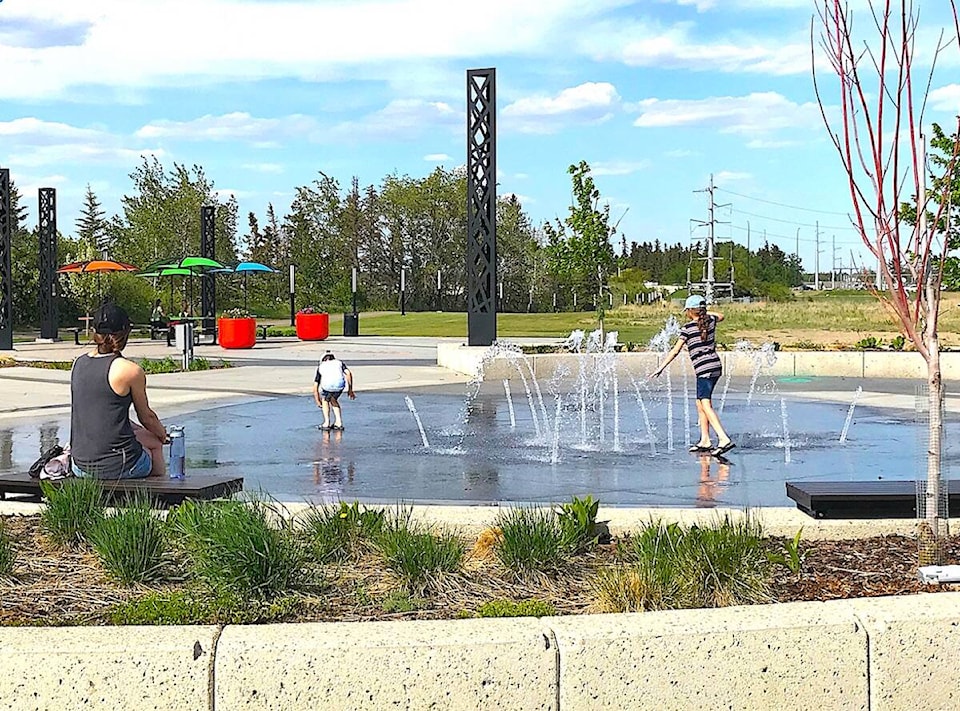The City of Red Deer is counting on having 5,000 people living in the Capstone area to avoid the pitfalls other cities face with urban renewal projects stealing businesses from their downtowns.
“Downtowns need people living there. That’s the best practice,” said the city’s manager of land and economic development, John Sennema on Tuesday.
Twenty years down the road, he envisions a thriving Capstone, with plenty of new businesses and recreational opportunities to serve a high-density neighbourhood.
Sennema can imagine activities from Capstone regularly spilling over into Red Deer’s adjacent historic downtown, where residents can walk to enjoy music and food on the Ross Street Patio, visit flowery City Hall Park and library, as well as attend special events in the community common in front of the Culture Services Centre.
But will this vibrant vision come to pass?
Former urban development consultant Richard White recently wrote a column in the Calgary Herald about how new urban renewal projects are negatively impacting Edmonton and Winnipeg’s downtowns.
Edmonton’s ICE District for sports and entertainment around the Rogers Place arena, according to White, is now competing with Churchill Square in front of City Hall as the “go-to-place” in the downtown, and further bleeding businesses from Jasper Avenue, Edmonton’s historic main street.
“The ICE District… just cannibalized existing office tower tenants and hotel visitors,” White states in his May 27 column. “Manulife Place office tower is like ghost town,” the downtown Hudson’s Bay closed in May 2020, “and the nearby Edmonton City Centre indoor shopping mall is deserted.”
White found a similar state of affairs in Winnipeg, where The Forks has become the new meeting place for locals as well as tourists, instead of the downtown.
Like Red Deer’s Capstone area, The Forks is near water. White states people like hanging out there instead of Portage Avenue, which has many empty stores — including the massive and iconic Hudson’s Bay, which closed in Nov. 2020.
Could Red Deer’s historic downtown — already struggling since COVID-19 and the ongoing opioid crisis — be emptied of businesses once Capstone gains momentum?
While Sennema feels there’s some validity to White’s viewpoint, he believes these concerns are more felt over a five-to-10 year span than 20 to 30 years in future — which is how city planning must be considered.
Cities are constantly evolving, with established businesses moving to more advantageous locations, freeing up more affordable core-area spaces for up-and-coming ventures, said Sennema. For instance, some downtown banks relocated to Clearview Ridge after that commercial centre was built — and the downtown has now gained 50 new businesses since last year.
Sennema believes the biggest difference between Capstone and the cited urban renewal projects in Edmonton and Winnipeg is that Red Deer’s is focused on having high-density residential units as an integral part of the redevelopment.
Having toured Edmonton’s ICE district, he noticed new hotels and some new City of Edmonton offices, but no new residential development.
Similarly, apartments or condos are not a focal point of The Forks, a market and meeting place at the confluence of the Red and Assiniboine Rivers in Winnipeg.
Having 5,000 residents in Capstone will be a big draw for out-of-town enterprises, which are routinely approached by City of Red Deer economic staffers to try to get them to open another location here, said Sennema.
New businesses have already sprung up in the Capstone/Cronquist areas to join more established ones. He noted the second outlet of the Dose coffee shop, as well as Purearth Organics, Wheeler’s bike shop, Wild Brewing Co. for kombucha, as well as Troubled Monk Brewery.
In the past few months, four different developers have called Sennema to express interest in potentially building high-density residential projects on that 20 acres of prime, riverside real estate. He remains hopeful that the first project will break ground in the spring of 2023 or 2024 — once inflation stabilizes and supply chain issues are resolved so developers are more confident of their costs.
“I am optimistic. I would be more concerned if my phone wasn’t ringing,” said Sennema.
In an email to the Advocate, White cautioned that people love living near water, so Capstone could turn out to be a more attractive place to live and play than “landlocked downtown Red Deer.
“It is going to be a challenge to make them work synergistically, in my opinion,” he added.
lmichelin@reddeeradvocate.com
Like us on Facebook and follow us on Twitter
